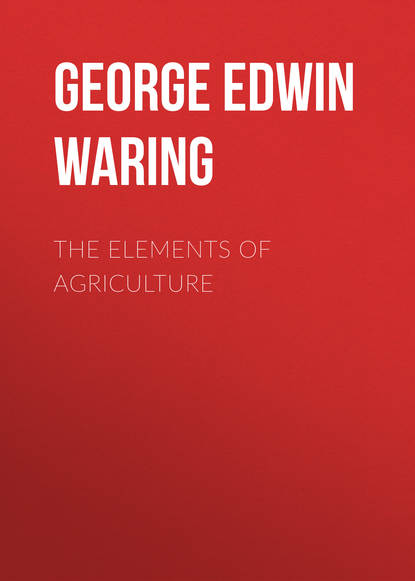По всем вопросам обращайтесь на: info@litportal.ru
(©) 2003-2024.
✖
The Elements of Agriculture
Настройки чтения
Размер шрифта
Высота строк
Поля
Alkalies and acids are of opposite properties, and when brought together they unite and neutralize each other, forming compounds which are neither alkaline nor acid in their character. Thus, carbonic acid (a gas,) unites with lime—a burning, caustic substance—and forms marble, which is a hard tasteless stone. Alkalies and acids are characterized by their desire to unite with each other, and the compounds thus formed have many and various properties, so that the characters of the constituents give no indication of the character of the compound. For instance, lime causes the gases of animal manure to escape, while sulphate of lime (a compound of sulphuric acid and lime) produces an opposite effect, and prevents their escape.
The substances coming under the signification of neutrals, are less affected by the laws of combination, still they often combine feebly with other substances, and some of the resultant compounds are of great importance to agriculture.
ALKALIES
The alkalies which are found in the ashes of plants are four in number; they are potash, soda, lime and magnesia.
POTASH
How may we obtain potash from ashes?
What are some of its agricultural uses?
When we pour water over wood ashes it dissolves the potash which they contain, and carries it through in solution. This solution is called ley, and if it be boiled to dryness it leaves a solid substance from which pure potash may be made. Potash left exposed to the air absorbs carbonic acid and becomes carbonate of potash, or pearlash; if another atom of carbonic acid be added, it becomes super-carbonate of potash, or salæratus. Potash has many uses in agriculture.
1. It forms a constituent of nearly all plants.
2. It unites with silica (a neutral), and forms a compound which water can dissolve and carry into the roots of plants; thus supplying them with an ingredient which gives them much of their strength.[4 - In some soils the fluorides undoubtedly supply plants with soluble silicates, as fluoric acid has the power of dissolving silica. Thus, in Derbyshire (England), where the soil is supplied with fluoric acid, grain is said never to lodge.]
3. It is a strong agent in the decomposition of vegetable matter, and is thus of much importance in preparing manures.
4. It roughens the smooth round particles of sandy soils, and prevents their compacting, as they are often liable to do.
5. It is also of use in killing certain kinds of insects, and, when artificially applied, in smoothing the bark of fruit trees.
The source from which this and the other inorganic matters required are to be obtained, will be fully considered in the section on manures.
SODA
Where is soda found most largely?
What is Glauber's salts?
What is washing soda?
What are some of the uses of lime?
Soda, one of the alkalies contained in the ashes of plants, is very much the same as potash in its agricultural character. Its uses are the same as those of potash—before enumerated. Soda exists very largely in nature, as it forms an important part of common salt, whether in the ocean or in those inland deposits known as rock salt. When combined with sulphuric acid it forms sulphate of soda or Glauber's salts. In combination with carbonic acid, as carbonate of soda, it forms the common washing soda of the shops. It is often necessary to render soils fertile.
LIME
Lime is in many ways important in agriculture:
1. It is a constituent of plants and animals.
2. It assists in the decomposition of vegetable matter in the soil.
3. It corrects the acidity[5 - Sourness.] of sour soils.
4. As chloride or sulphate of lime it is a good absorbent of fertilizing gases.
How is caustic lime made?
How much carbonic acid is thus liberated?
How does man resemble Sinbad the sailor?
In nature it usually exists in the form of carbonate of lime: that is, as marble, limestone, and chalk—these all being of the same composition. In manufacturing caustic (or quick) lime, it is customary to burn the carbonate of lime in a kiln; by this means the carbonic acid is thrown off into the atmosphere and the lime remains in a pure or caustic state. A French chemist states that every cubic yard of limestone that is burned, throws off ten thousand cubic yards of carbonic acid, which may be used by plants. This reminds us of the story of Sinbad the sailor, where we read of the immense genie who came out of a very small box by the sea-shore, much to the surprise of Sinbad, who could not believe his eyes, until the genie changed himself into a cloud of smoke and went into the box again. Sinbad fastened the lid, and the genie must have remained there until the box was destroyed.
Now man is very much like Sinbad, he lets the carbonic acid out from the limestone (when it expands and becomes a gas); and then he raises a crop, the leaves of which drink it in and pack the carbon away in a very small compass as vegetable matter. Here it must remain until the plant is destroyed, when it becomes carbonic acid again, and occupies just as much space as ever.
The burning of limestone is a very prolific source of carbonic acid.
MAGNESIA
What do you know about magnesia?
What is phosphoric acid composed of?
With what substance does it form its most important compound?
Magnesia is the remaining alkali of vegetable ashes. It is well known as a medicine, both in the form of calcined magnesia, and, when mixed with sulphuric acid, as epsom salts.
Magnesia is necessary to nearly all plants, but too much of it is poisonous, and it should be used with much care, as many soils already contain a sufficient quantity. It is often found in limestone rocks (that class called dolomites), and the injurious effects of some kinds of lime, as well as the barrenness of soils made from dolomites, may be attributed entirely to the fact that they contain too much magnesia.
ACIDS
PHOSPHORIC ACID
Phosphoric acid.—This subject is one of the greatest interest to the farmer. Phosphoric acid is composed of phosphorus and oxygen. The end of a loco-foco match contains phosphorus, and when it is lighted it unites with the oxygen of the atmosphere and forms phosphoric acid; this constitutes the white smoke which is seen for a moment before the sulphur commences burning. Being an acid, this substance has the power of combining with any of the alkalies. Its most important compound is with lime.
Will soils, deficient in phosphate of lime, produce good crops?
From what source do plants obtain their phosphorus?
Phosphate of lime forms about 65 per cent. of the dry weight of the bones of all animals, and it is all derived from the soil through the medium of plants. As plants are intended as food for animals, nature has provided that they shall not attain their perfection without taking up a supply of phosphate of lime as well as of the other earthy matters; consequently, there are many soils which will not produce good crops, simply because they are deficient in phosphate of lime. It is one of the most important ingredients of manures, and its value is dependent on certain conditions which will be hereafter explained.
Another use of phosphoric acid in the plant is to supply it with a small amount of phosphorus, which seems to be required in the formation of the seed.
SULPHURIC ACID
What is sulphuric acid composed of?
What is plaster?
What is silica?
Why is it necessary to the growth of plants?






